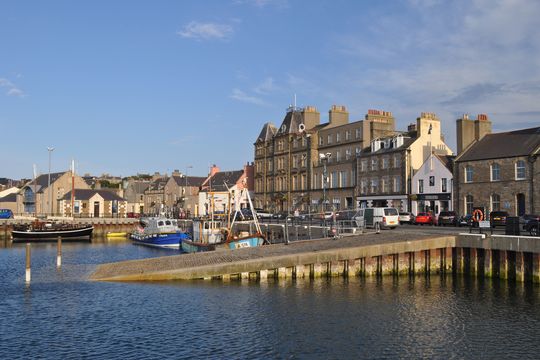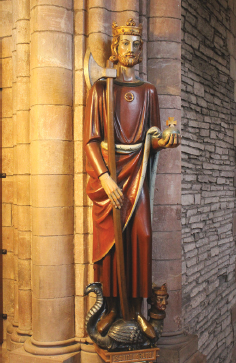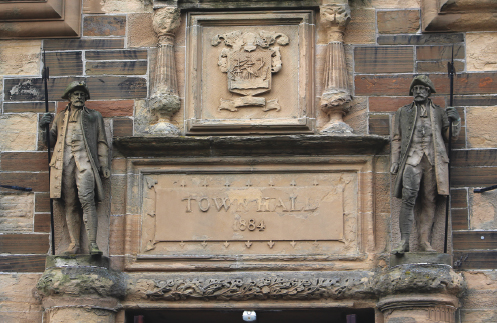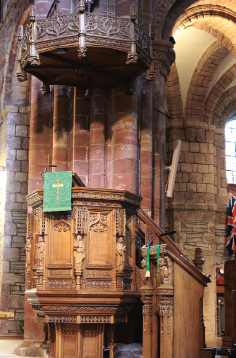
Kirkwall Harbour, in Orkney.Stevekeiretsu / Wiki Commons
The island’s only town is a gateway of people and goods. Though separated from the Scottish mainland by only 10 miles across the Pentland Firth, Orkney is one destination that really feels a world away.
From the 9th to 15th centuries, the northern island group lay in the hands of the Norse king, a thralldom held by earls. Ceded to Scotland in 1468, the islands’ Viking roots still echo in Kirkwall.
Of some 70 islands in the archipelago (depending on how you count), 20 are inhabited. Most folk, however, live on the largest island, Mainland Orkney. Its capital is the Royal Burgh of Kirkwall. With a population of 8,500, one-third of the Orkneys’ population calls Kirkwall home.
As the administrative and commercial center of the islands, Kirkwall is the islands’ distribution base for both people and goods. Kirkwall is indeed the gateway to the Orkneys.
Getting to Kirkwall is half the fun
It takes a bit of work to get to the Orkneys. This is no casual destination or a place to stop off on the way to somewhere else. You come to an island by plane or by ship. The principal commercial and passenger ferry route to Kirkwall is from Aberdeen on Northlink Ferries . It’s a six-hour crossing. Flights to Kirkwall (KOI) run from Aberdeen, Edinburgh, Glasgow, and Inverness principally via Flybe. Either way, you will enter Kirkwall at the Visitor Information Centre and Bus Terminal.
Make yourself at home
There are several mid-range centrally located hotels and a variety of B&B and guest house options in the heart of town. Kirkwall is very much a town that caters to visitors, and the West End Hotel, the Orkney Hotel, and the Kirkwall Hotel all rate highly with folk. The Kirkwall Hotel sits on the picturesque harbor, a classic three-star inn. Anywhere you locate, however, will be within easy walking distance of everything. The principal commercial street changes names several times (curiously from Victoria to Broad to Albert) but is never more than a couple of blocks away. It is narrow, colorful, and full of surprisingly interesting shops and eateries.
Kirkwall’s historic highlights
A Norse Earl, St. Rognvald, founded St. Magnus Cathedral in 1137 in memory of his martyred uncle (then the Earl). The Romanesque sandstone cathedral was built by master builders brought north from their work on Durham Cathedral. The remains of Magnus and his nephew still lie within the church’s ancient fabric. It is generally regarded as the finest medieval building in Northern Scotland.
On its annexation by Scotland, King James III gave the cathedral to the people of Orkney. Since the Scottish Reformation in 1560, the cathedral has been used for Protestant worship and is today a Church of Scotland congregation—still owned by the Kirkwall people and maintained by the Islands Council. Within the grand cathedral, the magnificent stained glass windows depicting saints and biblical personalities were created by artist Oscar Paterson in the 1920s.

The remains of St. Magnus and St. Rognvald lie behind the column next to Magnus’ effigy.
Next door, the remains of the 12th-century Bishop’s Palace and 16th-century Earl’s Palace reflect the long importance of Kirkwall as both a place of ecclesiastical and political power.

Civil government in the Orkney’s capital centers on the Victorian town hall in Kirkwall’s center.
Across the street at Tankerness House, a beautiful 16th-century townhouse, The Orkney Museum tells the story of the islands’ 5,000 years of social history. Its well-displayed collections include a wealth of archaeological artifacts, including a Viking boat burial; and don’t miss Tankerness House Garden through the back garden.
On the town outskirts, Highland Park Distillery produces the uniquely-flavored, award-winning single malt whisky. Take a tour of the distillery and the process, and sample a dram of Highland Park, proudly claimed “the best spirit in the world.”
Across the island
Kirkwall is a town that really can be largely “seen” in a day. Still, if you’ve taken the trouble to get here, it seems a shame not to stay for a bit and explore further. The island’s oldest evidence of human occupation is also its biggest attraction. In fact, the island’s Iron Age and Neolithic sites—the village of Skara Brae, Maeshowe and the Standing Stones of Stenness are among the most important archaeological sites in Europe. Book an excursion at the visitors’ center.
For those who would explore further afield, Orkney Ferries operates inter-island ferry service to 13 of the smaller islands.

St. Magnus’ 15th-century pulpit overlooks the long, narrow Romanesque nave. DANA HUNTLEY
Moving on from Orkney
Northlink ferry from Aberdeen continues on to the Shetlands’ capital town of Lerwick. Ferries also make the crossing from Stromness to Scrabster, and from South Ronaldsay to John O’Groats on the Scottish mainland. There is plenty to explore in the Highlands!
* Originally published in April 2016.





Comments